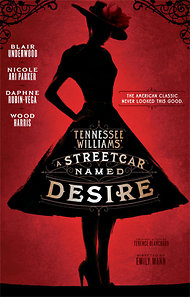
Image used for educational purposes only.
http://artsbeat.blogs.nytimes.com/2012/04/13/behind-the-poster-a-streetcar-named-desire/?_r=0
The play A Streetcar Named Desire by Tennessee Williams was originally displayed and depicted by white actors and actresses, such as the film adaptation in 1951. Recently the play was redone at the Broadhurst Theater in April of 2012, directed by Emily Mann and had a cast of black actors and actresses playing the leading roles.
I think this interpretation of having black actors in the leading roles gives an interesting twist to the original play. In an article I found on the website The Root by Celena Cipriaso she states, “When Blanche referred to Stanley as an “ape,” “sub-human” and “bestial” or Stanley derided Blanche’s “lily-white fingers,” the dialogue revealed a new layer of the interracial boundaries between the DuBois sisters and Stanley”.
I also feel the same way that the interracial boundaries that now exist between the characters give another level of understanding and maybe it also gives an easier and more explicit way to see the conflict between the characters. It is seen as Stanley is cast as a dark black man and Blanche and Stella are much lighter in skin tone than Stanley. In this version of the play, Blanche’s description of Stanley as “bestial” and “sub-human” can be seen as not only the effects of society on her gender but also the effect of society on her race. Looking at black history, we see that African Americans were seen as “sub-human” and animals due to their entrapment in slavery and racist beliefs people had. Now the struggle that you seen going on between the sisters and Stella’s husband is not only of one’s past but now also the factor of one’s race.
Finding out that the play was redone with a black cast made me think of the play in a different light and also helped to emphasize details in a much more powerful way than I had thought of them before. The play for me now is not only just a play about a woman struggling with her sexuality but also as one who is struggling with her sexuality and race.
-Nong T.
Sources
http://artsbeat.blogs.nytimes.com/2012/04/13/behind-the-poster-a-streetcar-named-desire/


It is really inspiring to look at the play in a more racial sensitive perspective. The Blanche probably projects some of racist belief into Stanley. Or She has some strong pride in her family background yet has no way to express. The conflict between Blanche and Stanley may also a clash between different value systems or life attitudes held between new working class immigrants and old aristocratic or elite (although Blanche has lost it status, she still admires such kind of value or life style).
This does offer a different look at the play. It’s interesting that just simply changing the race of the group of people the story is about can change what certain things mean. Like you said, the description of Stanley as sub-human takes on a new and racially charged meaning when played by a black actor. The conflicts throughout the play can be looked at through an intersectional standpoint with race and sexuality.
This response made me think back to the racial dynamics in “Quicksand.” Helga, with her lighter skin, demonstrated how their was a racial hierarchy within a racial hierarchy. Blanche in fact appears to be quite a bit like Helga; they are both trying to redefine or recreate themselves to escape society’s prejudice. What does it mean that they both seem to fail? While adding a new racial dimension, I think having a black cast also highlights the similarities among discriminated groups, ultimately creating more points for comparison.
Nong,
The use of a primarily black cast in A Streetcar Named Desire doubles up prejudices. It makes Blanche an example of one of the most oppressed groups of people in America, black women. I think that the added dimension of race makes the play even more striking and disturbing. I think you are right that by using an all black cast the play’s themes are highlighted even more, and there is also a whole new set of themes to consider.